What is airbag suspension? Airbag suspension is a vital component of modern vehicles that offers numerous benefits.
What Will I learn
- 1 What is Airbag Suspension?
- 2 Components of an airbag suspension system:
- 3 Pros of Airbag Suspension
- 4 Cons of Airbag Suspension:
- 5 Applications of Airbag Suspension
- 6 Airbag Suspension vs. Conventional Suspension
- 7 Cost and Considerations
- 8 Legal and Regulatory Considerations
- 9 Conclusion:
Airbag suspension in passenger vehicles enhances ride comfort, improves handling and stability, and provides adjustable ride height.
What is Airbag Suspension?
Airbag suspension, also known as air suspension, is a type of vehicle suspension system that utilizes airbags to replace traditional coil springs.
The concept behind airbag suspension is to provide a more adjustable and dynamic suspension system. It can adapt to various driving conditions and loads.
How airbag suspension works:
Airbag suspension works by using compressed air to inflate or deflate the airbags, which are positioned between the vehicle’s frame and axle.
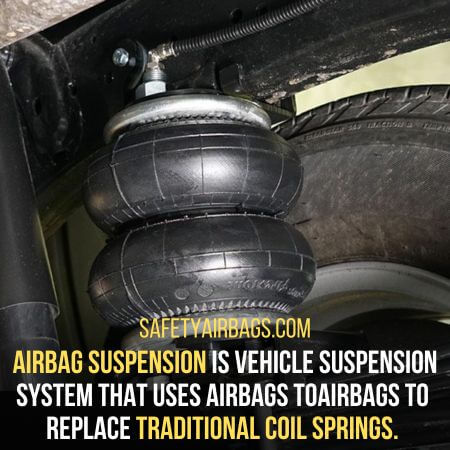
When air is pumped into the airbags, they expand and raise the chassis, increasing the ride height.
Conversely, when air is released from the airbags, the suspension lowers, reducing the ride height.
This adjustability allows for fine-tuning the vehicle’s stance and handling characteristics.
Components of an airbag suspension system:
Components of an airbag suspension system typically include airbags, airlines, air compressors, valves, and control systems.
These components adjust the vehicle’s ride height and provide a smoother and more comfortable ride.
1. Airbags:
The airbags are the central components of the airbag suspension system.
They are typically made of durable rubber or polyurethane.
Also, they are designed to withstand the pressures of supporting the vehicle’s weight and absorbing road impacts.
2. Air compressors:
Air compressors are responsible for pressurizing the air that fills the airbags.
They draw in outside air and compress it to the required level for suspension adjustment.
Compressors can be electrically powered or driven by the vehicle’s engine.
3. Control valves:
Control valves regulate the airflow into and out of the airbags.
They act as the interface between the air compressor and the airbags, allowing for precise adjustments to the suspension height and firmness.
4. Air lines and fittings:
Air lines and fittings connect the control valves to the airbags, ensuring proper air distribution throughout the system.
They are typically made of durable materials, such as nylon or stainless steel, to withstand the pressures and vibrations of the suspension.
5. Leveling sensors:
Leveling sensors monitor the vehicle’s ride height and detect changes in load distribution.
They provide feedback to the control system, allowing it to adjust the airbag pressure and maintain a level and balanced ride.
Pros of Airbag Suspension
Airbag suspension systems offer several advantages over traditional coil or leaf spring suspensions.
Here are some of the main pros of airbag suspension
1. Adjustable ride height:
One of the significant advantages of airbag suspension is its ability to adjust the vehicle’s ride height.
By inflating or deflating the airbags, the driver can raise or lower the chassis to suit different driving conditions, such as off–road terrain or highway cruising.
2. Load-leveling capability:
Airbag suspension systems excel at load-leveling, which means they can compensate for changes in vehicle weight.
The airbags can be inflated to maintain a level ride height when carrying heavy loads or towing trailers.
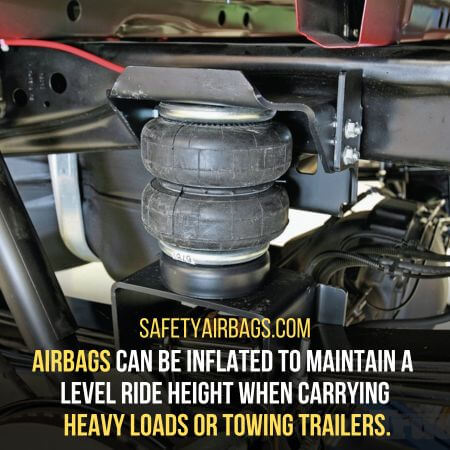
This prevents sagging and improves handling and braking performance.
3. Enhanced towing and hauling capacity:
With its load-leveling capability, airbag suspension significantly enhances a vehicle’s towing and hauling capacity.
By maintaining a level ride height and providing additional support, airbags help distribute the weight more evenly.
Thus, they reduce strain on the vehicle’s chassis and improve stability.
4. Increased stability and handling:
Airbag suspension contributes to improved stability and handling characteristics.
Adjusting the suspension’s firmness allows fine-tuning the vehicle’s response to cornering, reducing body roll and improving overall handling dynamics.
5. Enhanced Ride Quality:
Airbag suspension provides a smoother and more comfortable ride compared to traditional suspensions.
The airbags absorb shocks and vibrations from the road surface, reducing impact and improving overall ride quality.
This can be particularly beneficial when driving on rough or uneven terrain, as it helps minimize jolts and bumps inside the vehicle.
6. Load-Leveling Capability:
Airbag suspension systems are designed to maintain a level ride height, regardless of the weight or distribution of the load.
This load-leveling capability helps improve vehicle stability and handling by preventing sagging or squatting when carrying heavy loads.
It also helps to maintain consistent braking, steering, and traction control performance, contributing to safer driving conditions.
7. Improved Towing Performance:
Airbag suspension systems excel in enhancing towing performance.
Maintaining a level ride height and load distribution helps minimize trailer sway and improve towing stability.
This ensures safer and more controlled towing experiences, especially when dealing with heavy or unevenly distributed loads.
8. Customizable Ride Comfort:
With airbag suspension, drivers have the flexibility to customize their ride comfort.
By adjusting the air pressure in the airbags, they can achieve a softer or firmer ride according to their preference.
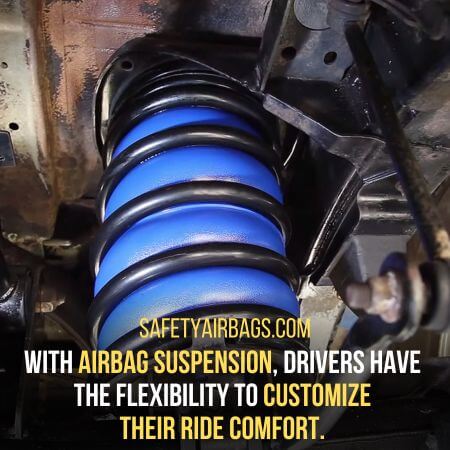
This level of customization allows for a personalized driving experience tailored to individual comfort needs.
Cons of Airbag Suspension:
While airbag suspension offers numerous benefits, there are also a few drawbacks to consider:
1. Higher Cost:
Compared to traditional suspension systems, airbag suspension tends to be more expensive to purchase and install.
The additional components and complexity of airbag systems contribute to their higher cost.
However, it’s important to note that the long-term benefits and improved performance may justify the initial investment for some individuals.
2. Maintenance Requirements:
Airbag suspension systems require regular maintenance to ensure optimal performance.
This includes checking airbag pressure, inspecting for leaks, and replacing worn-out components.
Neglecting maintenance tasks can lead to diminished performance and potential system failures.
3. Potential for Airbag Failure
Although rare, airbag failure in airbag suspension systems is possible.
Factors such as leaks, punctures, or electrical issues can result in a loss of air pressure and cause the suspension to malfunction.
Regular inspections and addressing any detected issues promptly can help mitigate this risk.
4. Limited Off-Road Capability
While airbag suspension can improve ride comfort on rough roads, it may have limitations in extreme off-road conditions.
The sensitivity of airbags to sharp impacts and the potential for damage in challenging terrains might restrict their effectiveness in demanding off-road situations.
In summary, airbag suspension systems provide adjustable ride height, enhanced ride quality, load-leveling capability, and improved towing performance.
They offer customizable comfort and can be beneficial for various driving needs.
However, they come with a higher cost, require regular maintenance, have a small risk of failure, and may have limitations in extreme off-road conditions.
Considering these pros and cons can help individuals make informed decisions about whether airbag suspension is suitable for their vehicles.
Applications of Airbag Suspension
Airbag suspension systems are commonly used in various applications, including automotive vehicles, heavy-duty trucks, RVs, and commercial vehicles.
They provide improved ride quality, load leveling, and adjustable ride height for enhanced performance and comfort.
1. Commercial vehicles:
Airbag suspension in commercial vehicles is commonly used in trucks, buses, and trailers.
It helps improve load stability, ride comfort, and handling, making it suitable for transportation, logistics, and delivery services.
1.1 Trucks and trailers:
Trucks and trailers commonly use airbag suspension systems to improve ride quality, load leveling, and stability.
They help minimize the effects of heavy loads and provide a more controlled and comfortable driving experience.
1.2 Buses and coaches:
Buses and coaches often utilize airbag suspension systems to enhance passenger comfort and stability.
The adjustability and load-leveling capabilities of airbags make them ideal for accommodating varying passenger loads and ensuring a smooth and controlled ride.
1.3 Delivery vans and cargo vehicles:
Airbag suspension can be found in delivery vans and cargo vehicles, where it aids in load distribution and stability.
The ability to adjust the ride height allows for easy loading and unloading and improved handling during transportation.
2. Recreational vehicles:
Airbag suspension systems in recreational vehicles (RVs) are utilized to enhance ride comfort, stability, and leveling.
They improve handling and reduce vibrations, making them ideal for motorhomes, campervans, and travel trailers.
2.1 Motorhomes and campers:
Motorhomes and campers often rely on airbag suspension systems to enhance ride comfort and stability.
The adjustable ride height and load-leveling capabilities make airbags ideal for these vehicles, ensuring a smoother and more enjoyable travel experience.
2.2 Caravans and travel trailers:
Caravans and travel trailers benefit from airbag suspension systems by improving stability and reducing the impact of uneven road surfaces.
Airbags help maintain a level ride height and distribute the weight evenly, resulting in better handling and reduced stress on the towing vehicle.
2.3 Fifth-wheel trailers:
Fifth-wheel trailers, which attach to the bed of a pickup truck, can also take advantage of airbag suspension systems.
The adjustability and load-leveling features make achieving a level connection between the trailer and the towing vehicle easier, enhancing stability and handling.
3. Passenger vehicles:
Airbag suspension in passenger vehicles enhances ride comfort, improves handling and stability, and provides adjustable ride height.
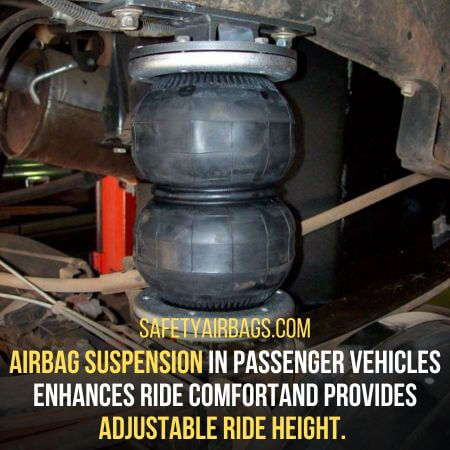
It is commonly found in luxury cars, SUVs, and high–performance vehicles.
3.1 SUVs and crossovers:
SUVs and crossovers increasingly use airbag suspension systems to provide a more comfortable and versatile driving experience.
The ability to adjust the ride height and compensate for varying loads makes airbags attractive for these vehicles.
3.2 Performance cars:
Some high-performance and sports cars utilize airbag suspension systems to enhance their handling capabilities.
The adjustable nature of airbags allows for precise tuning of the suspension to meet the demands of aggressive driving, providing better cornering stability and control.
3.3 Custom and modified vehicles:
Custom and modified vehicles, such as lowriders or show cars, often employ airbag suspension systems for their unique stance and adjustability.
Airbags allow for dramatic changes in ride height, enabling owners to achieve their desired aesthetic and driving characteristics.
Airbag Suspension vs. Conventional Suspension
The main difference between airbags and conventional coil spring suspensions is air-filled bags versus metal springs.
Airbag suspension offers greater adjustability and load-leveling capabilities, while coil spring suspension provides a simpler, more cost-effective solution.
1. Comparing ride quality, adjustability, and load capacity
Airbag suspension generally provides a smoother and more comfortable ride than coil spring suspension.
The ability to adjust the ride height and compensate for varying loads gives airbags an advantage in terms of versatility.
However, coil spring suspension may have higher load capacity in certain applications, such as heavy-duty trucks.
Cost and Considerations
The cost of airbag suspension systems can vary depending on several factors:
1. Installation costs and labor:
The installation costs of airbag suspension systems can also vary based on the vehicle’s complexity and the level of customization required.
Labor charges for professional installation should be considered when considering the overall cost.
2. Long-term cost implications:
While airbag suspension systems may have higher upfront costs compared to conventional suspension.
They can provide long-term benefits in improved ride quality, reduced wear and tear on other components, and enhanced vehicle resale value.
3. Factors to consider before opting for airbag suspension:
Before choosing airbag suspension, it is important to consider factors such as:
– The vehicle’s intended use
– Budget constraints
– Desired ride characteristics
– Availability of reputable installers and maintenance services in your area.
Legal and Regulatory Considerations
When installing airbag suspension systems, ensuring compliance with applicable vehicle safety regulations is crucial.
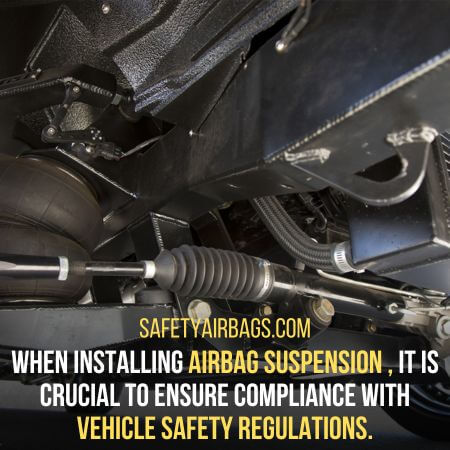
This includes following guidelines regarding suspension modifications and ensuring the system meets necessary safety standards.
1. State and local regulations regarding airbag suspension
In addition to national safety regulations, specific state and local jurisdictions may have additional regulations regarding airbag suspension installations.
Researching and complying with these regulations is essential to avoid legal issues and ensure roadworthiness.
2. Modifications and insurance coverage
Modifying a vehicle’s suspension, including installing airbag suspension, may affect insurance coverage.
It is important to inform the insurance provider about any modifications and understand the potential impact on coverage and premiums.
Conclusion:
When considering airbag suspension, weighing the benefits against the associated costs and potential legal and regulatory considerations is crucial.
Making an informed decision and opting for professional installation and maintenance will ensure optimal performance, safety, and regulation compliance.
